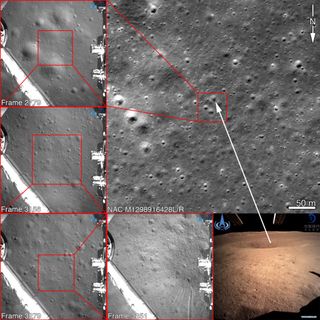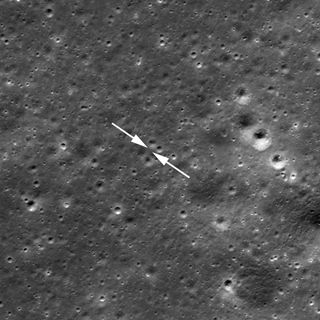
See China Moon Mission's Far-Side Landing Site from Above (Photos)

Scientists have used photos captured by NASA's Lunar Reconnaissance Orbiter (LRO) to further pinpoint the landing locale of China's Chang'e 4 far-side mission.
Looking at the just-released Chang'e 4 descent imagery allowed researchers to find the exact landing spot in a Narrow Angle Camera image produced by the Lunar Reconnaissance Orbiter Camera, or LROC. That image was taken prior to Chang'e 4's touchdown, explained LROC principal investigator Mark Robinson, who's based at Arizona State University in Tempe.
The LROC is a system of three cameras mounted on LRO that capture high-resolution black and white images and moderate-resolution multispectral images of the lunar surface. [Photos from the Moon's Far Side! China's Chang'e 4 Lunar Landing in Pictures]
Prominent crater
The Chang'e 4 lander-rover duo safely set down on the plains of Von Kármán Crater on the night of Jan. 2. Soon thereafter, a color image of the mission's immediate surroundings was relayed back to Earth.
Robinson said that the prominent crater, roughly 80 feet (25 meters) in diameter, in front of the lander can be seen in the LROC imagery. You can explore more of the area around the Chang'e 4 landing site via LROC's zoomify mode.
Toward the end of the month, LRO will be overflying Von Kármán and may provide imagery of the lander and the rover, which has been named Yutu 2. (The original Yutu was the rover on China's Chang'e 3 mission, which landed on the moon's near side in December 2013. You can see side-by-side comparisons of Chang'e 3 and Chang'e 4 descent imagery here.)
Future plans
Meanwhile, a senior Chinese space expert reported that China plans to deepen its lunar exploration plans, including establishing a scientific research station in the south polar region of the moon.
Get the Space.com Newsletter
Breaking space news, the latest updates on rocket launches, skywatching events and more!
Wu Weiren, an academician of the Chinese Academy of Engineering and chief designer of China's lunar exploration program, told China's state-run Xinhua news service that the country's current lunar program includes three phases: orbiting, landing and returning.
The first two phases have been accomplished, and the next step is to launch the Chang'e 5 probe to collect roughly 4 lbs. (2 kilograms) of lunar samples and bring them back to Earth, Wu said.
"We are discussing and drawing up the plan for the fourth phase of the lunar exploration program, including missions to the polar regions of the moon," Wu said, according to Xinhua.

Research station
Some places at the south pole of the moon receive sunlight for over 180 consecutive days. And the floors of some polar craters are never exposed to sunlight and might hold frozen water, scientists say.
"We hope to build a scientific research station in the south polar region of the moon. It would be operated automatically and visited by people for short periods," Wu said.
According to Xinhua, a heavy-lift carrier rocket, with a takeoff weight of about 4,400 tons (4,000 metric tons) and a diameter of 33 feet (10 m), is a goal for 2030. It would help realize the aim of bringing Mars samples back to Earth and sending Chinese astronauts to the moon.
Leonard David is author of the forthcoming book, "Moon Rush: The New Space Race" to be published by National Geographic in May 2019. A longtime writer for SPACE.com, David has been reporting on the space industry for more than five decades. Follow us @Spacedotcom or Facebook. This version of the story published on Space.com.
Join our Space Forums to keep talking space on the latest missions, night sky and more! And if you have a news tip, correction or comment, let us know at: community@space.com.

Leonard David is an award-winning space journalist who has been reporting on space activities for more than 50 years. Currently writing as Space.com's Space Insider Columnist among his other projects, Leonard has authored numerous books on space exploration, Mars missions and more, with his latest being "Moon Rush: The New Space Race" published in 2019 by National Geographic. He also wrote "Mars: Our Future on the Red Planet" released in 2016 by National Geographic. Leonard has served as a correspondent for SpaceNews, Scientific American and Aerospace America for the AIAA. He was received many awards, including the first Ordway Award for Sustained Excellence in Spaceflight History in 2015 at the AAS Wernher von Braun Memorial Symposium. You can find out Leonard's latest project at his website and on Twitter.
